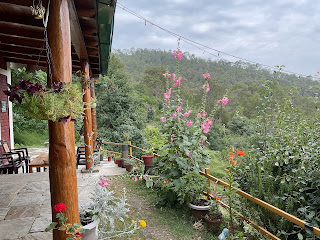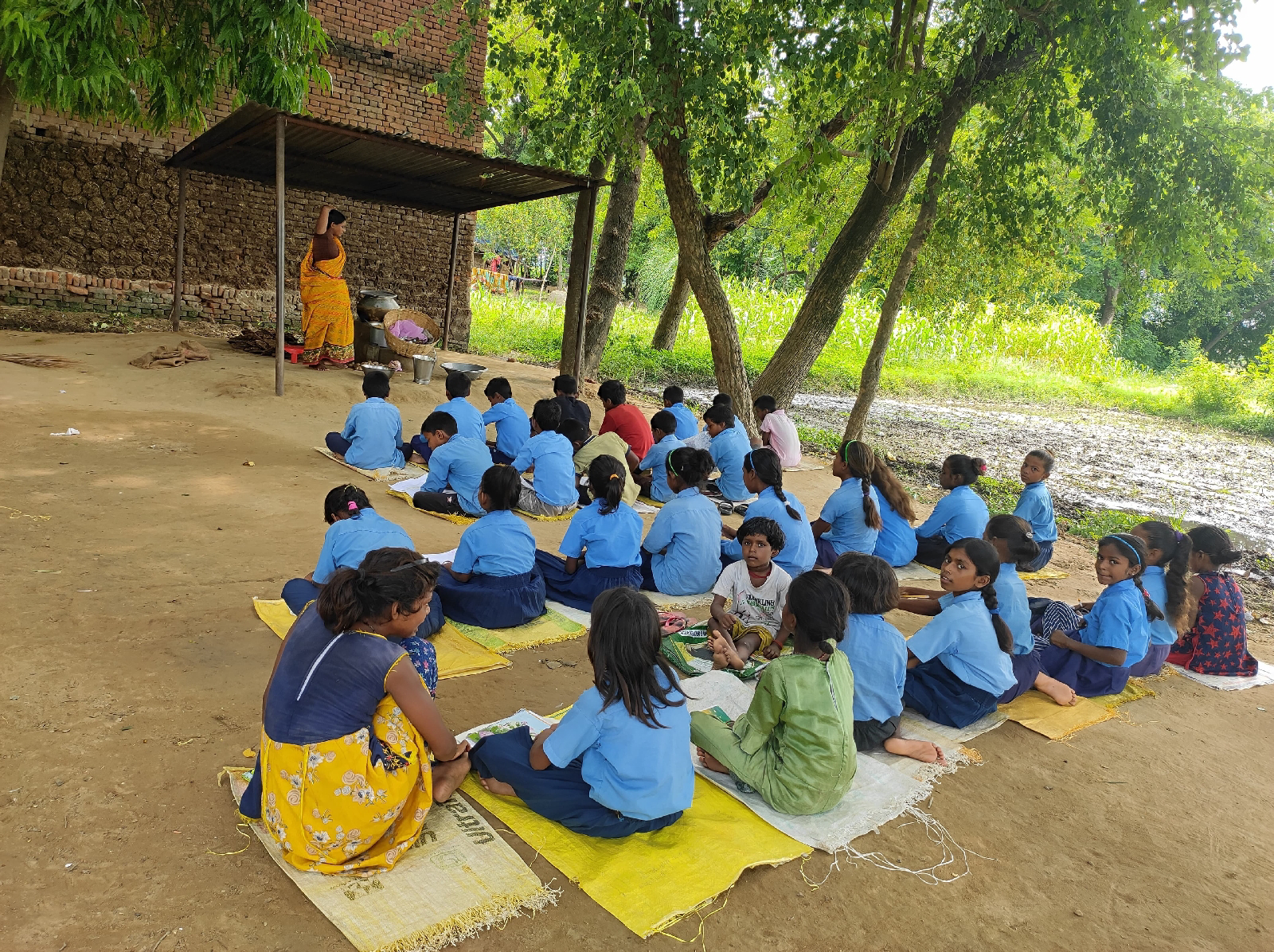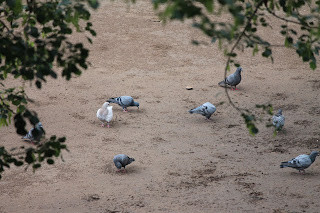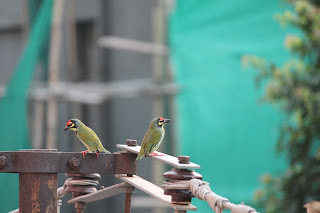S and I arrived just before her birthday at Peora village, near Satkhol of the Mukteshwar district in the Kumaon region of Uttarakhand as we have been doing now for a couple of years. Kumaon has been an ideal escape for us for from the heat, dust and lust of Delhi during the summers and over the visits we have made small connections with the small community of locals, regular visitors and people of the region including our wonderful host and home stay manager Yashwant and his family.
After allowing the restless thoughts of work and impulses of mind to settle down briefly in the evening with the nice cup of warm tea, soaking in the breathtaking views of Himalayas from our place and tuning in to the music of the birds, crickets and animals of the jungle we went to sleep with a plan to go on one of our familiar trails for a walk the next morning. The delicious parathas made over traditional chulha, the fresh curd and the finger-licking apricot aachar made from the fruits from the orchard of our host, briefly challenged the plans of the small trek with a temptation to lie down in the cozy bed and enjoy a morning siesta. We headed off, only because of another temptation - the sumptuous lunch that we would not have appetite for if we don’t walk off at least few of the parathas.
S and I started a conversation about consistency and experimentation. I called it the choice between security of familiarity versus the thrill of exploring the unfamiliar territory, quite literally in this case. We know this about ourselves - Yin and Yang. S would always prefer the comfort of the known and I would always go for the anticipated variety that the unknown offers. Even on our way up from the Kathgodam station, we talked about taking the familiar route we had taken last time and having our food at the same restaurant on the way or choosing a different path and a different option to eat. I prevailed this time. The route was much more picturesque with the unusually calm Bhimtal lake almost wearing a deserted look, again unusual for this time of the year where tourists from Delhi and nearby areas flock the hills and recreate the same crowd, cacophony and chaos that one tries to escape from. The restaurant was nice as well and just as I was revealing in my small victory in favour of experimentation and ‘trying the new’; the food undid us. No, not right away! It was nice when we tasted and ate it but signs of it not being fresh started showing up midway of the two hour drive to our place and that part of the choice didn’t augur well for us.
So, when it came to deciding which trail to take, we clearly tilted towards the familiar route we had taken quite a few times last year. S was quick to point out the virtues of consistency, treading carefully with a stick in her hand and quipping how the route is almost the same even after a year with no noise of new construction or no signs of destruction of trees and habitat. I was nodding my head and trying to walk past her when I realised that S has either stopped or suddenly disappeared into the thin mountain air. I could neither hear her soft voice, or footsteps or the prodding of stones with her stick. I then heard a loud voice, almost a roar ! I turned back to see S almost frozen, mid-way of her next step, mouth wide open and face red and eyes almost protruding out. It was clearly the reaction to the loud roar of an animal or a machine. I quickly told S with a shrugg of head that it must be a machine. There are no animals here so close to the main road, certainly not a leopard and definitely not at this time of the day. I wasn’t so scared myself though but I knew even if I concurred slightly with a ‘maybe’, we would have to immediately retreat and the next trails and walks would be in serious jeopardy. I suggested that we move ahead and reach to the tea shop and houses ahead in the trail. I also tried to make light of the matter joking that if a leopard really shows up, there is nothing for us to think and do! Whatever will be done, will be done by the beast, which can run upto 90 mph, can climb tall trees, has sharp nails and ferocious teeth. We are helpless in every aspect. The joke didn’t help much but the prospect of reaching habition and seeing another human face pushed S forward and she managed to reach the tea shop faster than me. People are mostly driven by two things, pleasure or fear !
For the next part of our walk back, at the tea shop, at the barbershop and to every other person whom S could meet and speak to, she had the same two question.
1. “Did you also hear a roar?”
2. “Is it possible that a leopard was around”
Most people, after giving an empathetic ear to this city dweller dismissed her apprehensions by citing the location and this time of the day. Some women, who had seen us walking on the that route remarked casually though that there might be a leopard who would have lent out that roar from far below in the dense jungle but you heard it here. So, there was a leopard ! S processed it in her own way and even at lunch and dinner she kept asking our hosts the same question and they kept brushing her excitement aside. S even tried to listen to voices of leopard, barking deer and other animals that were suggested by our host who was supremely confident that it couldn’t be the leopard. S was as sure as one is of one’s fear and I was as unsure as one is of anything one is unsure of. I had heard stories of leopard picking up one of the dogs of my previous hosts and had heard a roar of leopard once. I had of course been fascinated by Jim Corbett and his stories of the man-eater of Kumaon as a child which somewhat dwindled into disappointment in adulthood as I heard from many people of their disappointment of only seeing the footmarks or dung of the beautiful animal at the national park that bears the name of the famous English hunter. I was happy in my mind that these creatures still exist in real and not just in fiction and travel stories and am always keen to see them in the wild before we destroy these thriving ecosystems with our greed and avarice.
Clearly, S could not be persuaded for another morning trek even though a new trail was suggested this time. Thankfully I had some company in another family who had come in to the stay at the guesthouse. Ishan and I started early at 6.30 after failed attempts to persuade anyone else to join us in our leisurely walk to another small village through a jungle. Our host had suggested this route and cleared it of any wild animal, even sharing that this is the route taken by children of the village to walk many miles to come to their school - Aarohi Bal Sansar. We kept having small conversations as our walk started but as soon as the thickness of the vegetation, green cover of the trees increased and the width of the trail decreased our talks decreased and pauses of silence increased. I was walking ahead and we were super focussed on the path ahead. It was silent, it was almost meditative. There was slight wetness and dampness on the path, mostly due to the leaves wet due to the morning dew. The sun was up and peeped though the pine trees to look at two men from the cities trying to walk steadily though the unfamiliar terrain of the jungle. We only had the familiarity of our breaths, our steps and each other. Ishan started to share a little more about his life and was trying to catch up with me. I slowed down my pace as I realised he was having slight difficulty in breathing and talking at the same time.
Suddenly, I stopped as I saw something of a size of a Nilgai and then of the size of a goat moving almost like a bullet in front of me. I then saw a majestic, thick and big tail and the ‘thing’ vanish into the vegetation downhill. There was no doubt this time. It was the mountain leopard. A fully grown adult, dashing at maximum speed from uphill above the small foot trail to the jungle below at a distance of hardly twenty feet from me. It was so swift and fast that I had literally a fraction of a second to process and react. I reacted quite calmly to my own surprise and turned back to see Ishan also stopped and paused in his track, mouth wide open, eyed protruding and almost looking at me for answer or confirmation.
“It’s a leopard” I said it three times. Only then my heart started to process the information and started to beat a bit faster.
“yes, I saw something move very fast, are you sure it’s a leopard”
“200%! It had either seen us from above and didn’t wish to engage with us or it had a prey downhill that it dashed to chase and hunt”. I realised it was alternatively looking like a nilgai and a goat to me in two different frames my eyes could capture because of the speed that these magnificent beasts can manage to move.
The next thought in my head was to go and figure out what type of leopard we had seen. It was very clearly different from cheetahs that are yellow in colour, have dark, distinguished spots and are very lanky in shape. I did not manage to see the face of the animal but the entire big back was muscular and hefty.
Then the thought of our safety came and then Ishan followed up with the question - do we go ahead or go back. I thought for a while and then decided in favour of the familiarity of the road we had already covered and proximity of the human life there versus the unfamiliar jungle ahead and uncertainty of finding another person or house ahead. We certainly did not want to have the leopard, now familiar with us anywhere near us or to do anything to us ! We silently and softly walked back. There was no or little talk. This was pure fear and I am sure images of what will happen if the beast turns back or another one shows up were playing up in both our minds. Both of us picked up a stone each from the ground and grabbed it tight, more with hope than any strategy to fight or tackle the more powerful, faster and well-equipped master predator!
We walked up to the main road and while I was keen to go back to check on my phone what kind of leopard we had spotted, Ishan was keen on tea! We walked up to the nearest market, finished two cups of chai each at a local shop and walked back to our home stay on the same trail that S and I had taken the other day.
I could hear a lot of commotion in the room next to us with Ishan, Ekaansh, his son and wife Meenakshi exchanging exclamations, excitement and ethusisasm. Meanwhile, S lifted her head up from the razaai (blanket) and asked me with half-opened eyes, “what happened?”
Nothing!






























